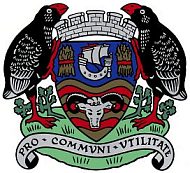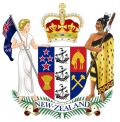Invercargill: Difference between revisions
Knorrepoes (talk | contribs) No edit summary |
Knorrepoes (talk | contribs) No edit summary |
||
| (10 intermediate revisions by the same user not shown) | |||
| Line 1: | Line 1: | ||
{| | {| class="wikitable" | ||
|- style="vertical-align:top;" | |||
| | |[[File:invercag.nz.jpg|center|350 px|alt=Arms (crest) of {{PAGENAME}}]] | ||
| | |||
<center>''' {{uc:{{PAGENAME}}}} '''</center><br> | |||
'''Country''' : New Zealand [[File:newzealand.jpg|60 px|right]]<br><br><br> | |||
'''Region''' : Southland | |||
{{#display_map:-46.4128, 168.3482|width=250|height=250|zoom=7}} | |||
|} | |} | ||
''' | {| class="wikitable" | ||
|+Official blazon | |||
|- | |||
|'''English''' | |||
| blazon wanted | |||
|} | |||
===Origin/meaning=== | |||
The arms were granted on 25th July 1958. | The arms were granted on 25th July 1958. | ||
The shield, topped by a mural crown, denotes a body corporate and is the | The shield, topped by a mural crown, denotes a body corporate and is the emblem of local government administration. The symbols of the shield are two sheaves and a ram's head, indicative of the agricultural and pastoral prosperity of the province, whilst the ship is a symbol of overseas-borne | ||
emblem of local government administration. The symbols of the shield are two | |||
sheaves and a ram's head, indicative of the agricultural and pastoral | |||
prosperity of the province, whilst the ship is a symbol of overseas-borne | |||
trade. | trade. | ||
The city was named after Captain Cargill, associated with the House of | The city was named after Captain Cargill, associated with the House of Drummond. The three red wavy bars behind the head are from the arms of the House of Drummond. | ||
Drummond. The three red wavy bars behind the head are from the arms of the | |||
House of Drummond. | |||
The supporters are two Notornis (a.k.a. Moho or Takahe), birds, first | The supporters are two Notornis (a.k.a. Moho or Takahe), birds, first discovered in Fiordland in 1856. Presumed to be extinct, they were re-discovered in 1948. The foliage of the surrounds is Southland beech. | ||
discovered in Fiordland in 1856. Presumed to be extinct, they were | |||
re-discovered in 1948. The foliage of the surrounds is Southland beech. | |||
The Latin inscription "Pro Communi Utilitate" means "For the benefit of the community." | The Latin inscription "Pro Communi Utilitate" means "For the benefit of the community." | ||
[[Literature]] : http://www.invercargill.org.nz/html/coat_of_arms.htm | [[Literature]]: http://www.invercargill.org.nz/html/coat_of_arms.htm | ||
{{nz}} | |||
{{media}} | |||
[[Category:New Zealand]] | [[Category:New Zealand]] | ||
[[Category:Granted 1958]] | [[Category:Granted 1958]] | ||
Latest revision as of 05:53, 28 October 2024
|
Country : New Zealand Region : Southland |
| English | blazon wanted |
Origin/meaning
The arms were granted on 25th July 1958.
The shield, topped by a mural crown, denotes a body corporate and is the emblem of local government administration. The symbols of the shield are two sheaves and a ram's head, indicative of the agricultural and pastoral prosperity of the province, whilst the ship is a symbol of overseas-borne trade.
The city was named after Captain Cargill, associated with the House of Drummond. The three red wavy bars behind the head are from the arms of the House of Drummond.
The supporters are two Notornis (a.k.a. Moho or Takahe), birds, first discovered in Fiordland in 1856. Presumed to be extinct, they were re-discovered in 1948. The foliage of the surrounds is Southland beech.
The Latin inscription "Pro Communi Utilitate" means "For the benefit of the community."
Literature: http://www.invercargill.org.nz/html/coat_of_arms.htm
New Zealand heraldry portal
This page is part of the New Zealand heraldry portal |
Heraldry of the World |
|
Civic heraldry:
|
Other heraldry: |
Contact and Support
Partners:
Your logo here ?
Contact us
© since 1995, Heraldry of the World, Ralf Hartemink 
Index of the site













